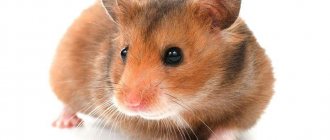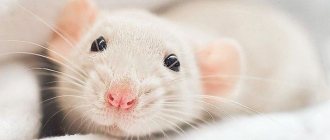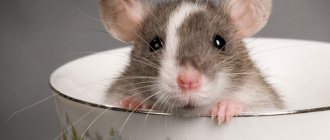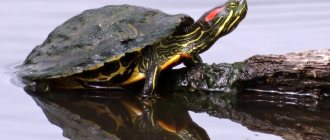Djungarian hamsters are very small and incredibly cute furry creatures native to the northwestern province of China called Dzungaria. However, today these babies are one of the favorite pets all over the world, and therefore many want to know how long such a pet will live. The answer to this question is publicly available, The average lifespan of a Djungarian hamster is 2-3 years, it is extremely rare that these fluffies live 3.5-4 years.
What determines the lifespan of a Djungarian hamster?
Any external factors greatly affect the condition of a small animal, so the issue of maintenance must be taken seriously.
Care
- Provide your pet with a decent home, while taking into account the unshakable hamster rule: “ Each dwarf has a separate cage . These harmless animals are actually very sensitive to the issue of their territory, and any “stranger” in their cage can lead the dwarf to aggression and even a fight.
- Clean the rodent's cage in a timely manner, avoid the accumulation of garbage and excrement, the smell of which can quickly spread throughout the house.
- To prevent your small rodent from getting hurt, do not buy cotton wool for it. The hamster runs the risk of getting entangled in it, and the cotton wool can wrap around any part of the tiny body. Instead, it is better to bring napkins to the hamster's cage - this is the best option for building nests.
Give your pet the attention it needs just as much as cats and dogs.
- Protect your hamsters' ears from any noise, be it the radio, TV or loud conversations . This can create a stressful situation for your pet.
- Also exclude any bright light, which these nocturnal animals do not like. Most of all, they cannot tolerate daylight; it is also harmful for them to be in direct rays.
What should jungarika eat?
Nutrition
Healthy food is another success on the path to longevity for your pet. To do this, add the following to your animal’s diet:
- Ready-made nutritional formulations. Such kits are sold in pet stores; they represent proper balanced nutrition , which is selected specifically for hamsters. They often contain corn, wheat, peas and nuts - everything that rodents love so much.
- Fresh fruits and vegetables. Focus on zucchini and carrots, and it is better to exclude cabbage and onions, as they can harm the health of jungarians. All citrus fruits should be excluded from fruits, and apricots, bananas and apples are the most optimal for hamsters.
Protein is another substance that keeps your pet healthy. In order for the dwarf to get protein, give him meat several times a week.
- Special vitamins. It is better to discuss recommendations for their purchase directly with a specialist.
- Regularly replenish your rodent's water bowl with water. IMPORTANT: Water must be distilled.
Genes
Like humans, hamsters may have a genetic predisposition to diseases . Thus, genes sometimes result in the development of certain diseases. Therefore, when purchasing, it is better to get a hamster that had healthy parents.
Also, genetics can have a hamster's life expectancy for the better. If a rodent has long-livers in its family, then it will probably live a long time. Such a gene can also have a positive effect on the animal’s immunity. This means that it will be more resistant to disease. The right decision would be to contact professional hamster breeders, so you can find out more about the parents of the future pet.
Did you find out about your pet's pedigree before purchasing?
What do Djungarians often get sick with?
Diseases
Since you are dealing with a helpless animal, you need to monitor its health very carefully. Especially if you want to ensure a long and happy life, then monitor illnesses in advance using symptoms such as:
- Decreased activity.
- Constant fatigue and lethargy.
- Drowsiness.
- Labored breathing.
- Deterioration of fur.
If one of the symptoms appears, you should immediately consult a doctor . The earlier you detect the disease, the easier it will be to get rid of it.
- The Dzungarian may catch a cold, which is usually indicated by sneezing and sniffling. In this state, the animal needs your care and attention, while feeding your pet fresh fruit - this way he will recover faster. IMPORTANT: Use any medications or injections only with a doctor’s prescription.
A problem with teeth may be indicated by the fact that the hamster is not eating well. The cause may be damage to the oral cavity or overly long incisors. Probably, because of the pain, it is simply difficult for the pet to chew food. In this situation, only a doctor can help; in some cases, the procedure to shorten the length of teeth is carried out at home.
- Djungarians may also experience intestinal and stomach diseases . This can be determined by loose stools, an unpleasant odor, or rumbling in the animal’s tummy.
- The animal may also develop a tumor disease, but you should not make hasty decisions if you just find a lump or lump. In this case, you need to consult a doctor for an accurate answer.
- Protect your pet from fractures , because a serious injury can leave your pet lame for the rest of its life. In case of watering, bruising or other damage, immediately take the hamster to the veterinarian, only he will give you the correct recommendations for recovery.
How long can a hamster live without active movement?
Like any living creature that can jump and run, the dzhungarik cannot be healthy without an active lifestyle. To keep your animal in good shape, provide it with the necessary equipment: exercise equipment, walking balls or a wheel.
Remember that a hamster will not be able to live long with plenty of food and little activity , this can lead to intestinal diseases, which can have harmful consequences. To avoid this, constantly give him space to be active, be it his crate or the floor of your apartment.
At what age is it better to buy a hamster?
How many years do Djungarian hamsters live in the wild?
The habitat of exotic animals has long been no longer limited to the Chinese provinces. Wild hamsters of this breed have taken root in many regions of Siberia, Kazakhstan, and the Caucasus. The animals are small enough and careful not to catch the eye of humans. Their body length is approximately 10 cm. In the wild, small rodents are exposed to daily threats from larger competitors for food and predators.
In nature, Djungarian hamsters are constantly in search of food. They run over 10 km every day to provide themselves with the necessary amount of food. During the warm season, restless dwarfs actively accumulate food reserves for the winter and create extensive storage facilities in their burrows.
Experts believe that regular stress, constant tension, and every minute expectation of an attack negatively affect the health of hamsters and shorten their lives. As a rule, the Djungarian hamster lives in freedom for no more than one and a half years. Some individuals have high immunity and live 2–2.5 years. Sometimes the age of a hamster can be determined by the number of scars on the body of a hamster. The lifespan of animals directly depends on the presence and combination of several factors:
- amount of food in the area where rodents live;
- physical condition of hamsters;
- predator population density;
- weather.
Quite often, wild hamsters suffer from hypothermia or injuries. As a rule, such dwarfs die quickly, despite their age. Hamsters become prey for foxes, stoats, owls or snakes.
How to extend the life of a Djungarian hamster: basic rules
If your task is to significantly extend the life of your hamster, providing him with the maximum possible longevity, then take each of the above points seriously.
- Respect the natural environment of dwarfs, which do not tolerate bright light. To do this, place the cage away from the window so that the animal does not receive unnecessary stress from excess daylight.
- Take care of your pet's hygiene. Since the rodent spends most of its time in the cage, constantly clean it . At least once a week it is necessary to wash the entire house, periodically change the bedding there and remove excrement. This will ensure clean and fresh air around the cage space.
- “We are what we eat” is a phrase that also applies to Djungarians. Feed him exclusively healthy food, while relying on the animal’s natural preferences. Sometimes give him harmless treats in the form of a piece of banana or apple. This will significantly lift the animal’s mood and give a new boost of energy.
- The basis of nutrition should be grains and legumes , such as corn grains, peas, seeds, nuts, rice grains and wheat.
- As mentioned earlier, you can purchase ready-made nutritional mixtures at pet stores; these kits include all the useful components for your pet.
- Do not exclude meat from his diet, which is rich in protein and healthy fats.
All about dzungarians - video
If all of the above conditions are met, your pet can live a long and happy life. In addition to the basic rules of care, do not forget about love and care. These little creatures are constantly in need of someone's help, so always be ready to provide it.
Additional recommendations
Tips from hamster owners:
- If you want to have 2 or more rodents, the spacious cage is divided with a piece of plexiglass.
- When breeding hamsters, immediately after mating, the male is placed separately. Males like to live alone, and males also eat newborns.
- They do not let the pet out of the cage: it moves so quickly that it is easy to lose sight of it. Having become entangled in clothes, the animal gnaws and spoils things in order to find a way out.
- They prevent the animal from falling, because he doesn't feel heights.
The Djungarian hamster is an unpretentious animal. Conscientious care prolongs your pet's life.
Taking care of your health
Signs of illness
There are quite a few symptoms indicating the onset of the disease in hamsters. These include aggression, and unmotivated aggression, ulcers on the body or baldness, apathy, breathing problems, loss of appetite and loose stools. If you observe one of the above symptoms, you should immediately contact your veterinarian.
Most common diseases
Among the most common diseases:
- Cold.
- Injuries (dislocations, fractures).
- Intestinal disorder.
- Conjunctivitis.
- Cataract.
Prevention
Many diseases are mainly caused by poor care. In addition to this, you should not constantly move the cage, change your pet’s daily routine, or introduce a new hamster. All this leads to stress, which is dangerous for the health of jungarians.
General information
Djungarian hamsters are rodents that can grow up to 10 centimeters in length. Their fur is short and smooth. As a rule, hamsters have a grayish-brown color. However, in the off-season their fur may lighten or darken.
These creatures have a good disposition and almost instantly get used to the hands of their owner. Such pets never refuse human contact. Hamsters are extremely playful, which children like.
Djungarians do not belong to the category of social animals. Representatives of the species are true loners. To exist normally in captivity, they do not require company, like rats and other rodents. Such hamsters prefer to completely control the territory under their control. And if necessary, they are ready to zealously defend their own home.
Determining the age of the pet
The life expectancy of Djungarian hamsters is 2-3, sometimes 4 years, but this is in exceptional and very rare cases. And although this is not as much as, for example, cats or dogs, do not be sad about this, and feel free to get yourself a little furry friend, even if for such a short period of time he will become your faithful companion. Before buying an animal in a store, it is important to determine how old it is. This is quite difficult to do; even zoologists will not be able to give you an accurate answer to this question. There are several factors by which it is still possible to distinguish a small dwarf from its more adult counterpart.
- Young animals are very active and inquisitive, always strive to communicate with people, enthusiastically run around the cage and happily eat various delicacies. Older rodents are calmer and slower. They live a measured life, love to sleep and try to hide in their house.
- Its appearance will also help determine the age of the hamster. The fur of fluffies acquires its first color within a week after birth. But after 14 days it not only becomes thick and smooth, but also, as a rule, changes color to a permanent darker color.
- The age of the animals is revealed by their weight and length. Usually at 2 months the size of babies does not exceed 8 cm, and already at 5 months old the hamster weighs up to 40 g. Therefore, if you want to determine the age of your pet, you should definitely weigh and measure it.
Reproduction
To mate and successfully reproduce Djungarian hamsters, you will need a female about four months old and a three-month-old male. For breeding purposes, they need to be transplanted into a separate container for a while, protected from their relatives.
Pregnancy among Djungarians takes about 20 days. After the specified time, from 4 to 12 cubs can be born. Hamsters are born blind and helpless. Over the next month, they are under the care of their mother, regularly drinking milk.
There are a number of other important points when breeding Djungarian hamsters. So, shortly before giving birth, it is necessary to place the female in a pre-cleaned, disinfected cage. And after the babies are born, you should not pick them up or touch them. Having smelled foreign odors from the cubs, the female may reject the offspring. In such situations, cases of cannibalism are often observed.
Breeding
Length of pregnancy
Djungarians are fertile animals. Females older than 4 months are capable of breeding. Their pregnancy lasts 3 weeks.
Caring for a pregnant female
Firstly, a pregnant female should be fed even more food. So, the diet should include granulated food and protein (boiled chicken, eggs, cottage cheese). Secondly, you need to prepare the room for future offspring in advance: disinfect all the contents of the cage.
Care of offspring
There is no need to feed the cubs: they drink mother's milk for 3 weeks. Under no circumstances should you pick them up, as the mother may smell someone else's scent on them and eat them.
Factors influencing lifespan
Djungarian hamsters are very small and vulnerable creatures. It is necessary to provide your pet with the best living conditions. It is also necessary to take care of the habitat of your pets. Djungarians cannot stand other pets near them. The most important thing for keeping them is to provide each hamster with its own cage. If several animals live in one cage, they will constantly fight among themselves. This lifestyle will quickly shorten the Djungarian hamster's lifespan.
Cotton wool should not be allowed to be in the pet's home . If cotton wool accidentally gets wrapped around a pet, the rodent may die from suffocation. If a hamster swallows a little cotton wool, it will begin to have digestive problems. If your pet wants to make a nest, you can put a napkin or paper on it. These materials are safe.
The Djungarian hamster requires a lot of attention. You need to play with the animal, talk, show your care and love. There is no need to turn on the TV, radio or other equipment that may create noise for your hamster. The animal is very sensitive; if there is constant noise and commotion around it, the hamster’s health will deteriorate.
Also, Djungarian hamsters need to be protected from direct sunlight. Animals do not like too bright light; it deteriorates the pet’s health. The home must be located so that the sun's rays cannot enter it. In order for a rodent to live a long time, it is necessary to take timely care of its home. It is impossible for garbage and waste products to accumulate in the cage. Litter needs to be removed once every 2 days. A complete cleaning of the cage should be done every week.
Preparing for content
External conditions
Hamsters' housing should not be located near noisy objects (for example, next to a TV) or radiators. It is not advisable for pets to get sunlight, so it is better to place the cage somewhere in the shade. The last condition is the absence of drafts. Otherwise, hamsters will get sick often.
Cage requirements
So, when choosing a cage for your Djungarian hamster, there are a few things to keep in mind. It should be spacious enough. The standard size is 30 by 50 centimeters. It is advisable to choose horizontal rods, since the pet will be able to crawl on them. Of course, we should not forget about the internal contents of the cell.
It is better to buy a house made of ceramic or wood, but they are expensive. It is believed that a plastic house is an ideal option both in terms of quality and price. It’s better not to choose a cardboard house, even though it costs the least. The hamster's home should be spacious, and the opening should be such that even with puffy cheeks the hamster could go inside.
Where to put the cage
The question often arises about where to put the cage. In this case, it is better to focus on external conditions. No sunlight, no drafts. In order not to disturb the rodents, it is better to place the cage away from sources of strong noise.
Possibility of keeping in an old aquarium
You should not keep hamsters in an aquarium. They don't like this: at the sight of human hands they begin to go crazy and rush at them. In addition, the aquarium creates an additional danger in the form that the air in it is poorly ventilated. As a result, bacteria begin to appear that are dangerous for dzhungariks.
Filler selection
Another important condition for the well-being of dzhungarika is bedding with the right filler.
Here's a short overview of popular options:
- Hay. A good option, as it is closest to natural conditions. In addition, the hamster will be able to make a nest out of it or even feast on it.
- Sawdust. Their main disadvantage is poor odor absorption. Nevertheless, this is one of the cheapest options, and the Djungarians themselves love to dig into it.
- Wood filler. The same sawdust, only pressed. However, it contains wood dust, which is dangerous for rodents. In addition, the filler is very large, it will be uncomfortable for the cubs to walk on it.
It is worth remembering that the choice of filler is no less important than the cells. And under no circumstances should you use cotton wool for this.
Feeder and drinker
In general, dzhungarikas do not like feeders, so they often turn them over with all their contents. Therefore, it is better not to place glass products, as there is a chance that they will break.
It is better to take an automatic drinker rather than a regular bowl. The second hamsters will quickly turn over.
Wheel, other toys, bath
An important component of any cage are toys. The wheel will help your dwarf hamster spend his extra energy somewhere. The pet store has a fairly large assortment of different tunnels, stairs, and the like for your pet. For the same purposes, you can add various branches or plant roots to the cage.
Under no circumstances should you wash the jungarik in water. You need to buy a special bathing suit and fill it with sand. It is there that the hamster will independently take all the actions he needs to clean his fur.
Diseases
Various diseases have a bad effect on the Djungarian hamster's immunity. If a pet gets sick, it will live less. Symptoms of disease: lethargy, low activity, the pet is drowsy, the quality of the coat deteriorates, breathing becomes intermittent. If even one sign occurs, you should immediately consult a veterinarian. If measures are not taken, a disease may develop.
There have been cases when the hamster could fall. Animals are playful and curious, so they can sometimes climb onto the edges of the table and accidentally fall. If this happens, the hamsters can damage their paws and get bruises and scratches. There is no need to treat Djungarian hamsters yourself. It is better to take the rodent to the veterinarian.
Article on the topic: Hamster with stuffed cheeks, cheeky hamster, cheek pouches
Animals can get colds, then they will sniffle and sneeze. If your pet is sick, then he needs to be given more attention and given food that contains many vitamins. Only a veterinarian should prescribe medications and injections. If your Djungarian hamster is not eating well, it may have dental problems. Some teeth may have wounds or become elongated. If this happens, then a veterinarian should shorten them.
If Djungarian hamsters have a rumbling stomach and loose stools, this means that the animal has digestive problems. There have been cases when a Djungarian hamster could develop a tumor. Only a veterinarian can detect it, so the rodent must be periodically shown to a specialist.
You need to know that diseases may not always appear due to the owner’s carelessness. Although in most cases everything depends on the pet itself - immunity, character, and heredity are important.











